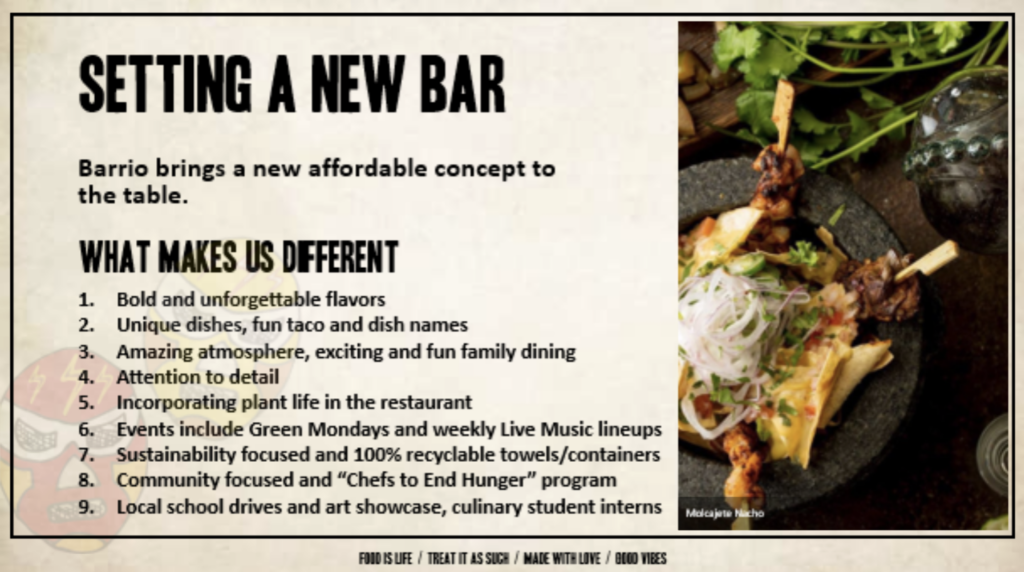

Launching a new restaurant is exciting, but it’s also expensive! If you don’t plan to fund the venture yourself, you’ll want to bring financial backers on board. This means you’ll need a compelling restaurant pitch deck to sell your idea.
Having a concept deck or pitch deck for a restaurant is critical to sharing your vision in a way that gets others invested in it (pun intended). The right pitch deck can make or break your ability to raise the funding you need to get your business off the ground. But don’t worry – creating a pitch deck doesn’t have to be daunting. In this article, we’ll cover:
You’ll be a success story in no time! Suit up, entrepreneur – let’s get started.
If you’re new to the startup world or have yet to partner with investors to fund a restaurant venture, you may be wondering what the term “pitch deck” means. Essentially, it’s a sales presentation tool.
If that sounds a little dry, rest assured that a pitch deck is anything but boring. It’s more like the Robin to your Batman – a visual aid to support you as you deliver a compelling presentation to potential investors. Your pitch is your shot to show them why your restaurant is worth taking a chance on, and your pitch deck plays an integral role in the process.
“A pitch deck is a collection of slides, typically arranged in Microsoft PowerPoint or Google Slides. Its purpose is to present a startup business idea or thesis, or to document an existing business and project the outcome of venture investment,” according to Alejandro Cremades, serial entrepreneur and the best-selling author of The Art of Startup Fundraising.
Companies across a variety of industries use pitch decks. And while they’re especially common in the tech world, pitch decks can be a valuable asset for restaurateurs, too. In the restaurant industry specifically, a pitch deck should communicate why a venture is a sound financial investment. It should also focus heavily on your concept, location, and customers.

Download this customizable restaurant business plan template to create a professional business plan for your new venture.
Get the TemplateNow that you’re familiar with the idea of a pitch deck for a restaurant, let’s talk about when you might want to use one.
You need a restaurant pitch deck whenever you want to sell your vision and get buy-in for your business – for example, when you want to secure restaurant investors, or bring someone onto your team like a new business partner.
You may choose to seek investors if you’re looking for financial support and expertise to launch a new restaurant or expand an existing one. Working with investors will not only bring vital funding to the table, but also a business-savvy perspective that can help guide the future of your restaurant.
As long as you’re not concerned with losing some control over the business (and some of the profits), this can be a great option. And it’s precisely when you’ll need a stellar pitch deck.

We’ve covered the basics – now it’s time to roll up your sleeves and learn how to build a pitch deck for your restaurant that will bring in the cash you need.
Here are the most important slides to include in your restaurant pitch deck:
This slide is where you introduce your big idea at a high level. What do you envision for the future of your restaurant, and what value will it bring to the market?
For example, you may want to bring the first farm-to-table fine dining concept to your town that will help promote a culture of appreciation for fresh food supplied by local producers.
Your restaurant should address a consumer need. So, what problem will your restaurant solve?
This slide of your pitch deck might be fairly cut and dry if you’re proposing a concept that doesn’t yet exist in your city or town. On the other hand, if you’re planning to open a pizza restaurant in a crowded market, you’ll need to clearly illustrate the gap (or problem) that persists, despite the existence of your competitors.
As is often said in the marketing industry, if your brand is for everyone, it’s for no one. This is why you need to specify which kind of customers you’re looking to attract to your restaurant.
For example, you may want to open a wine and tapas bar that caters to couples and young professionals. The opportunity could be your location’s proximity to downtown residential buildings and office towers, combined with a lack of similar bars in the area.
This slide of your pitch deck is where to get to show off your big idea some more. What, specifically, will you offer at your restaurant, and how will it solve the problem you outlined previously for your chosen target market?
Let your passion for your concept and food shine through here. You should be excited about your restaurant to get others feeling the same way!
Now we’re getting down to brass tacks. This is your moment to show investors that you’ve given careful thought to how your restaurant will earn revenue.
For example, perhaps you’re looking to open a brewery that will sell food, beer (in-house, wholesale, and retail), and merchandise like hats and sweatshirts. This is all important information to include in your pitch deck.
What makes you so sure your idea is viable? Present your market research and assure investors that your market wants what you’re proposing. If you have competitors, this is a good time to nod to their success.
How will you get the word out about your restaurant and drive sales? The marketing and sales tactics you plan to use, like advertising, email marketing, loyalty programs, gift cards, specials, and more should all be outlined on this slide.
This slide of your pitch deck, and the next two, are the ones investors tend to spend the most time viewing, so it pays to get the content right.
You’re not going on this wild ride alone, so who will be helping you get your restaurant off the ground? Investors want to know who you’re bringing on and what kind of experience each team member has.
Have you secured any funding for your restaurant to date? If you’re able to show that others have backed you, it could inspire confidence in future investors.
Be sure to also include financial projections of future performance (and records of past performance, if you’re pitching an existing restaurant or concept to new investors).
Investors want to know what else in the market they’d be going up against if they were to support you. Even if you don’t have any direct competitors, where else might your target market choose to spend their time and money dining out?
It’s time to make it clear what you’re looking for. What level of investment are you seeking, and how do you plan to use the funds? For example, you may want to earmark the funds to purchase kitchen equipment, or to pay for a major marketing campaign.

Download this customizable restaurant business plan template to create a professional business plan for your new venture.
Get the TemplateDon’t forget about the aesthetics of your pitch deck! You might have the most innovative restaurant concept to hit the market in years, but without the right visual presentation, it could fall flat. Here are 3 tips to consider when crafting your concept deck.
Don’t leave the details of your restaurant up to interpretation. Instead, wow your potential investors with striking visuals of your food and venue. This is a key part of presenting your restaurant concept well, so investors can see how it will fill a gap in your market.
If your restaurant hasn’t been built yet, you can use commercial renderings to give your investors a clear picture of what the finished product will look like. This can help answer questions and even expedite the permitting process, which is a plus in investors’ minds.
Show your investors that you bring more than a passion for food to the table. Creating a pitch deck with a cohesive look and feel that matches your restaurant branding can go a long way in putting your best face forward during your pitch. It will give investors confidence that you’ve got a marketing mindset, which is a crucial element of business success.
Remember, inconsistency in the fonts and colors throughout your presentation can distract and detract from your message, and that’s the last thing you want when you’re trying to raise the big bucks! Make it easy for investors to see how awesome your idea is.
Your pitch deck shouldn’t contain your full restaurant business plan. Considering that investors spent 24% less time reviewing pitch decks in 2022 than in 2021, your pitch deck needs to make a good first impression, fast, to get their attention.
“On average, you have just under three minutes to convince [investors] to take a meeting with you,” reports TechCrunch. “In fact, for decks that fail to raise funding, investors give up in just two minutes and 13 seconds. That’s not a lot of time…so you’ve got to make it count.”
One way to make sure the most important information shines through on your pitch deck is to keep the text on your slides to a minimum. While you’re at it, keep the slides to a minimum, too. Some entrepreneurs argue you should have no more than 10 slides, but don’t worry too much if you go over – Uber’s first pitch deck contained 20+ slides, and they secured more than enough funding right out the gate.

Now that you know how to build a pitch deck, let’s explore some real-world restaurant pitch deck examples to give you inspiration for your own.

The Odd Burger brand consists of both a vegan fast food chain, as well as a plant-based food manufacturing company. Odd Burger’s pitch deck plays into the brand’s ‘industry disruptor’ persona by starting off with a thought-provoking hook: “You can create a better world by eating fast food. Doesn’t that seem odd?”
In addition to its bold vision, Odd Burger’s pitch deck also contains valuable information about the company’s smart kitchens, automation technology, distribution partnerships, expansion plans, and customer reviews. The deck also provides solid financial and market data. However, at 35 slides, this pitch deck is a bit long.

Freshii leans on its mission of making healthy food convenient and affordable, as well as several impressive growth statistics in this pitch deck. The deck showcases Freshii’s unique market position, innovative menu, and strong financial performance.
Franchise information is another key part of Freshii’s pitch deck. The brand outlines its current global franchise network and plans for growth, which is great inspiration if you’re wondering how to franchise a restaurant yourself.

Barrio’s pitch deck is highly visual, with striking images of the restaurant’s food as well as its design concept. The deck uses text sparingly on the slides, and the text that is included speaks to what makes the restaurant unique.
Another highlight of Barrio’s pitch deck is the focus on the team behind the vision, which you now know is an important feature for investors.
With all of these tips and examples in hand, we hope you’re feeling confident to get out there and pitch your restaurant. We can’t wait to see what’s next for you!

Download this customizable restaurant business plan template to create a professional business plan for your new venture.
Get the Template
Katherine is the Content Marketing Manager at TouchBistro, where she writes about trending topics in food and restaurants. The opposite of a picky eater, she’ll try (almost) anything at least once. Whether it’s chowing down on camel burgers in Morocco or snacking on octopus dumplings in Japan, she’s always up for new food experiences.